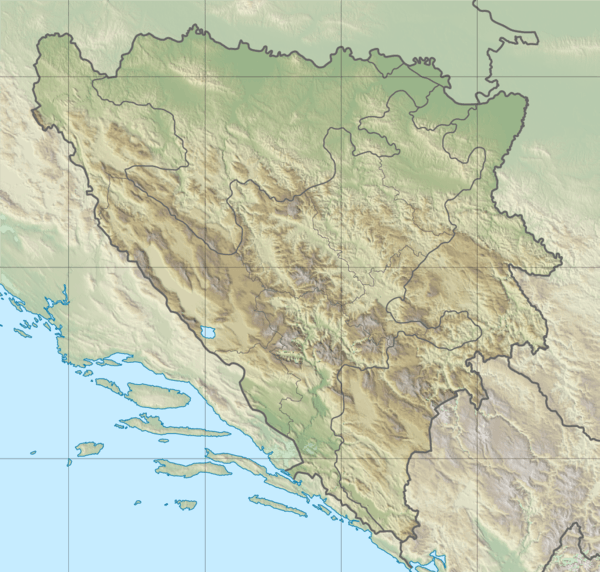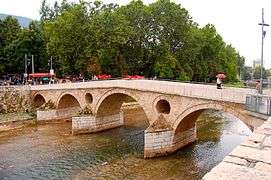Miljacka
The Miljacka (Cyrillic script: Миљацка) is a river in Bosnia and Herzegovina that passes through Sarajevo.
| Miljacka Paljanska Miljacka and Mokranjska Miljacka | |
|---|---|
Miljacka in Sarajevo | |
 | |
| Location | |
| Country | Bosnia and Herzegovina |
| Municipality | Pale, Istočni Stari Grad, Stari Grad, Novo Sarajevo, Novi Grad, Ilidža |
| Physical characteristics | |
| Source | Paljanska Miljacka Gornje Pale |
| • location | Pale |
| • coordinates | 43.787836°N 18.572217°E |
| • elevation | 1,025 metres (3,363 ft) a.s.l. |
| 2nd source | Mokranjska Miljacka Mokro Cave |
| • location | Kadino Selo near Mokro |
| • coordinates | 43.924791°N 18.595741°E |
| • elevation | 0 a.s.l. |
| 3rd source | Confluence of the two Miljacka, Mokranjska & Paljanska |
| • location | near Bulozi, Stari Grad |
| • coordinates | 43.8347241°N 18.4889174°E |
| • elevation | 1,135 metres (3,724 ft) |
| Mouth | Bosna river |
• location | Bojnik, Sarajevo |
• coordinates | 43.869409°N 18.290759°E |
| Length | Mokranjska Miljacka 21 kilometres (13 mi); Paljanska Miljacka 13 kilometres (8.1 mi); from the confluence to mouth in Bosna 21 kilometres (13 mi) |
| Discharge | |
| • average | 5.7 cubic metres per second (200 cu ft/s) |
| • minimum | cca. 2.5 m³/s |
| Basin features | |
| Progression | Bosna→ Sava→ Danube→ Black Sea |
| River system | Danube>Black Sea |
| Landmarks | Bentbaša |
| Tributaries | |
| • left | Bistrica (Jahorinska), Bistrički Potko |
| • right | Lapišnica, Mošćanica, Koševski Potok |
| Waterbodies | Bentbaša |
| Bridges | Goat's Bridge (Bosnian: Kozija Ćuprija), Šeher-Ćehaja Bridge, Careva ćuprija, Latin Bridge (aka Principov most), Ćumurija Bridge, Drvenija Bridge, Čobanija Bridge, Festina lente bridge, Skenderija Bridge (aka Ajfelov most), Suada and Olga bridge (aka Vrbanja most) |
Characteristics
The Miljacka river originates from the confluence of the Paljanska Miljacka and Mokranjska Miljacka rivers. The Miljacka is a rather small river, only 21 kilometres (13 mi) long from the confluence, or 34 kilometres (21 mi) and 42 kilometres (26 mi) depending on source (Pale or Mokro), with an average discharge of 5.7 m³/s into the Bosna river in Sarajevo. The Miljacka river flows from east to west general direction.
Paljanska Miljacka
The Paljanska Miljacka, 13 kilometres (8.1 mi) in length, begins Gornje Pale, 10 kilometres (6.2 mi) eastward in the town of Pale, under the slopes of Jahorina, near Begovina), at the elevation of 1,025 metres (3,363 ft).
Mokranjska Miljacka
The Mokranjska Miljacka, 21 kilometres (13 mi) in length, springs from a large cave, yet to be fully explored, near the village of Kadino Selo at an elevation of 1,135 metres (3,724 ft) near the base of Romanija mountain.
Mokranjska Miljacka cave
The cave at the spring of Mokranjska Miljacka, located about 7 kilometres (4.3 mi) from the village of Mokro, near Pale, is officially the longest cave in Bosnia and Herzegovina, with length of mapped caverns so far at 7.2 kilometres (4.5 mi), as of August 2015.[1] The Miljacka runs out of the cave practically as an underground flow, a subterranean river, where its temperature is measured as low as 5 degrees and temperature of air as low as 8 degrees Celsius.[1][2]
The exact location of the cave is not yet mapped out for the public, but local authorities have released a map which can be used to find its location as well as a gallery of discoveries within the cave.[3]
New species of spiders, named Nemanela Lade ("Lada's Little Monster", namsake of its discoverer PhD Lada Lukić-Bilela from Institute for Genetic Technology, Sarajevo), along with at least five more species of spider, as well as certain species of bats, have been found there. A skeleton head of a cave bear has also been found at the location.[4][5] Paleontological finds, traces of human habitation, stalactites and stalagmites, as well as pisolite rocks, the river Miljacka wellspring, all makes this cave among most valuable speleological objects in Bosnia and Herzegovina.[2] Researchers believe to have discovered bubbles of air, a possible sign of tectonic activity.[6]
Environment
Because of its poor discharge, the Miljacka is known for its peculiar smell and brown waters. Miljacka river cascades, which regulate the waterbed and enrich the water with oxygen, trap plastic scraps, stranded balls, car tires, and various other waste. The main collector that drains fecal matter is parallel to the flow of the river up to its mouth at the river Bosna. The sewer system is not connected to the main collector, causing leakage of fecal matter directly into the waters of the Miljacka in several places. During the Bosnian War, water treatment was stopped and plant equipment was looted, preventing the local government from dealing with the issue. Estimations of the cost to repair the wastewater plant range from 50 to 60 million euros.
In April 2015, a project called Čista rijeka Miljacka (Clean river Miljacka) was presented. The aim of the project is to bring the river status to category A, which would make the water clean enough for swimming.[7]
In August 2015, Sarajevo Grad signed a contract with ER Project d.o.o. company to clean up 48 river cascades from Šeher-Ćehaja bridge to Dolac Malta suburb bridge.[8]
Floods of 2014
The river swelled almost to the level of city bridges during the 2014 Southeast Europe floods, which brought significant flooding to Bosnia and Herzegovina.[9][10]
Bridges
There are over a dozen bridges over the river Miljacka. Some of the better known ones are:
- Goat's Bridge (Bosnian: "Kozija Ćuprija")
- Šeher-Ćehaja Bridge
- Careva ćuprija
- Latin Bridge (also known as "Principov most", namesake of Archduke Franz Ferdinand's assassin Gavrilo Princip). The famous assassination carried out by Princip, which lead to World War I, took place at the entrance on this bridge. Gavrilo's co-conspirator Nedeljko Čabrinović, another member of the Bosnia-Herzegovinian Mlada Bosna movement, just seconds after throwing a grenade toward the archduke's car jumped into the river Miljacka from the bridge, in an attempt to hide underneath and thus buy enough time so that he could take and swallow a cyanide powder wrapped into a piece of paper. But this plan failed him as the poison got so wet from the fall into the shallow Miljacka (only 10 centimetres (3.9 in) deep) that it not only dissolved, mostly, but also lost its effectiveness. He was dragged out alive and arrested.
- Ćumurija Bridge
- Drvenija Bridge
- Čobanija Bridge
- Festina lente bridge
- Skenderija Bridge (a.k.a. "Ajfelov most")
- Suada and Olga bridge (a.k.a. "Vrbanja most)
- Bosmal Bridge (Malaysian-Bosnian Friendship Bridge), a.k.a. "Malezijski most" and "Bosmalov most".[11]
- and number of unnamed modern bridges.
Diving
Bentbaša Cliff Diving is a sport organized at location Bentbaša dam every summer at the eastern entrance into the city of Sarajevo (in close proximity to Vijećnica, a library and former City Hall). The diving location water depth is at 3.5 to 4.4 meters depending time of month.[12][13] Support to this sport in Sarajevo was given by Red Bull Cliff Diving World Series champion Rhiannan Iffland and competitor Jonathan Paredes who attended the 2019 edition.
Past champions of the event:
Image gallery

- Fishing on Dariva (Miljacka Canyon between Bentbaša and Goat's Bridge)
 Wilson's Promenade, named after Thomas Woodrow Wilson
Wilson's Promenade, named after Thomas Woodrow Wilson The Latin Bridge was the site of the assassination of Franz Ferdinand
The Latin Bridge was the site of the assassination of Franz Ferdinand- Bentbaša dam (Cliff Diving location)
.jpg) Library and City Hall
Library and City Hall
Popular culture
A number of popular local songs where sung about Miljacka river, including "Halid Bešlić - Miljacka" and "Himzo Polovina - Kad ja pođoh na Bembašu".
References
| Wikimedia Commons has media related to Miljacka. |
- "Izvor Mokranjske Miljacke: Najduža dokumentovana pećina u cijeloj BiH". bosanskiportal.com. 22 August 2015. Archived from the original on 23 September 2015.
- "Pećina na izvoru Mokranjske Miljacke najduža u BiH". klix.ba. 15 August 2011.
- "Pećina(Cave) izvora Mokranjske Miljacke". palelive.com. 10 September 2015.
- "Slobodna Bosna broj 665 (Scribd PDF download)" (PDF). Scribd. 13 August 2009. Retrieved 26 July 2018.
- "PALE-SARAJEVO: MILJACKA - OD IZVORA DO UVORA". Govore ljudi - Youtube. 10 September 2014.
- "Izvor Miljacke je mamac za avanturiste". sarajevo.co.ba. 24 May 2009.
- "Prezentiran projekt "Čista rijeka Miljacka"". Klix.ba (in Bosnian). Retrieved 26 July 2018.
- "Iz Miljacke se u naredna tri mjeseca uklanjaju plastične flaše, lopte, šiblje i drugi otpad (FOTO)". Klix.ba (in Bosnian). Retrieved 26 July 2018.
- https://www.klix.ba/vijesti/bih/policija-zabranila-prelazak-mosta-na-drveniji-u-sarajevu-zbog-vodostaja-miljacke/140514103
- http://balkans.aljazeera.net/vijesti/sarajevo-miljacka-narasla-gotovo-do-mostova
- Destination Sarajevo,The Malaysian-Bosnian and Herzegovinian Friendship Bridge, accessed 24 August 2017
- https://sarajevo.travel/en/event/bentbasa-cliff-diving-2019/15578
- https://www.radiosarajevo.ba/sport/ostali-sportovi/dan-kada-bentbasa-ozivi-skakaci-iz-cijelog-svijeta-impresionirali-sarajlije/346414
- Karl Baedeker (Firm) (1905). Austria-Hungary, Including Dalmatia and Bosnia. Original from the University of Michigan: K. Baedeker. p. 431.